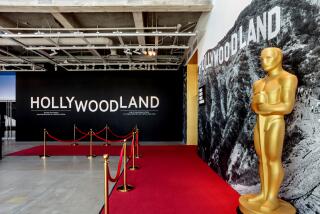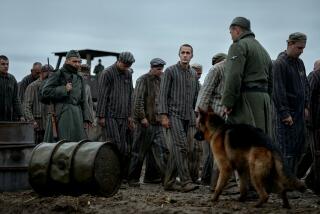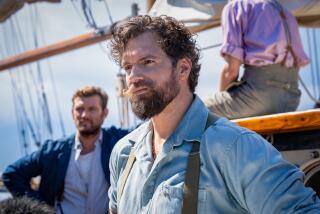Hollywood’s war effort
- Share via
NEW ORLEANS -- What a difference a few decades can make.
Hollywood has taken on a leading role in the Iraq war debate, lending its political voice against the invasion and offering up any number of films examining the war’s personal costs. But as a new show at the National World War II Museum makes clear, the relationship between the movie business and international armed conflict hasn’t always been so polarized.
While the exhibition, “Real to Reel: Hollywood and World War II,” wasn’t purposely designed to dramatize this then-and-now juxtaposition, visitors to the impressive Louisiana museum can’t help but notice the 180-degree shift.
“This is not just a show about how Hollywood affected the war,” said the museum’s marketing director, Clem Goldberger, “but about how the war affected Hollywood.”
It’s not just that some of the town’s biggest stars -- including Douglas Fairbanks Jr., Jimmy Stewart and Sterling Hayden -- left the movie business to become decorated soldiers, pilots and spies. The more interesting difference is to see through the exhibit’s artifacts and displays how closely Hollywood and the White House collaborated. The two pooled resources not only to build support for the war before America’s entry but also to generate a steady stream of training films and propaganda movies to make sure the nation grew ready and united.
Prewar effort
Well before the Japanese bombed Pearl Harbor in 1941 and while the United States and Germany were officially still at peace, a handful of anti-fascist filmmakers was creating movies challenging America and Britain’s isolationist bearings.
Among the first films highlighted in the exhibit are Charlie Chaplin’s 1940 comedy “The Great Dictator,” which ridiculed Hitler and Mussolini, and Russian-born Anatole Litvak’s “Confessions of a Nazi Spy,” a 1939 drama arguing that the Germans were determined to crush democracy. Both films were denounced (and investigated) by Sen. Gerald Nye, a Republican senator from North Dakota and a strong supporter of the America First Committee, which argued against America’s entry into the rapidly escalating global conflict.
By the early 1940s, though, the relationship between Hollywood and Washington had changed dramatically, in ways that seem inconceivable today. As the small but thoughtfully curated exhibition (which runs through Aug. 31) makes clear, the U.S. Office of War Information believed the movie business could help win the war, and it published a manual to guide filmmakers on how best to merge art and politics without being didactic.
The excerpts from the OWI manual offer one of the exhibition’s most compelling displays. Read today, the government’s suggestions feel like script notes from a recent film school grad. “Audiences don’t want to listen to lectures,” one OWI memo says. “They want to identify themselves with the characters they see on screen. They react coldly to being told to do something, but they are strongly influenced by being shown.”
Another OWI dispatch prompts moviemakers to remind audiences of the “unsung heroes” of the Merchant Marine and not to neglect the “calm, smiling” nurses in Bataan. Another suggests that civil rights messages will help coalesce war support: “The Negroes have a real, a legal and a permanent chance for improvement of their status under democracy and no chance at all under a dictatorship.”
The OWI also encouraged filmmakers and studios to depict our Soviet Union allies favorably. Among the resulting films were Lewis Milestone’s “The North Star” (1942), Michael Curtiz’s “Mission to Moscow” (1943) and Gregory Ratoff’s “Song of Russia” (1944).
But the movies came with a costly personal price. Even though Warner Bros. asked “Casablanca” co-screenwriter Howard Koch to write “Mission to Moscow,” Jack Warner subsequently called him a communist sympathizer. Called before the House Committee on Un-American Activities (HUAC), Koch refused to name names and was subsequently blacklisted and had to write under a pseudonym. “Song of Russia” scribe Paul Jarrico, who refused to testify before HUAC, also was blacklisted, left the United States and never reestablished an American screenwriting career.
“The government wanted us to reach out to the Russians and be allied with them,” said curator Stacy Peckham, the assistant director of collections and exhibits. “And then some of them ended up getting dragged into” the hearings.
Wartime films
The exhibition grew out of a film conference held at the museum in mid-April, and clips of WWII-era movies (both narrative and documentary) and posters promoting them occupy a central place in the show. Rather than focus on more recent movies about the war (“Saving Private Ryan,” for example), the emphasis is solely on contemporaneous works. Among the films represented are Frank Capra’s “Why We Fight,” John Ford’s “The Battle of Midway,” John Huston’s “The Battle of San Pietro,” George Stevens’ “D-Day to Berlin” and Louis Hayward’s “With the Marines at Tarawa.”
The distinguishing characteristic of the overall museum, which opened in 2000 as the National D-Day Museum and was re-christened six years later as the National World War II Museum, always has been its personal stories. Its two main permanent galleries focus on the European and Pacific campaigns, and visitors are able to listen to numerous compelling oral histories from veterans of both theaters.
In trying to bring similar personal stories to its temporary Hollywood show, the museum has emphasized the exploits of a number of prominent stars who served. The tales remain mesmerizing these many years later. Henry Fonda, ordered to make training films, instead lobbied to join in Air Combat Intelligence and served on the seaplane tender Curtis. Clark Gable worked not only in the 1st Motion Picture Unit but also was an observer-gunner in a B-17 Flying Fortress. Fairbanks sailed in the Navy and helped plan some of the decoy D-day invasions designed to confuse the Germans.
Hayden’s saga
Few tales, though, are as Hollywood-worthy as Hayden’s. After having made but two forgettable films (1941’s “Virginia” and “Bahama Passage”), Hayden left Hollywood for the Marines. He made his way into the Office of Strategic Services, changed his name to John Hamilton and became a spy in Greece and Yugoslavia, smuggling weapons past the Nazis.
Even though Hayden received the Silver Star, he was called before HUAC. Hayden not only renounced his former membership in the Communist Party but also named names, a decision he later regretted.
Located just a short walk from French Quarter, the museum was spared from flooding during 2005’s Hurricane Katrina, but its better-than-average gift and coffee shops were looted and the museum didn’t reopen for three months. Out-of-state attendance plummeted after the storm, and only now is the museum starting to see a steady stream of non-local visitors.
The “Real to Reel” show is but one step in a push to bring filmmaking into the National World War II Museum experience. As part of a $300-million expansion, the museum is building a 4-D (the normal 3-D, with weather effects and rumbling seats thrown in) theater, which will house the Tom Hanks-produced documentary “Beyond All Boundaries.” The film and the theater are set to open in the summer of 2009.
London’s Imperial War Museum may offer a more imposing collection of World War II hardware and exhibits, and the Palm Springs Air Museum, with its stunning collection of airworthy fighters and bombers from the 1940s, is a lot easier to get to. But if you are fascinated by Hollywood’s complicated history in the politics of warfare, a trip to New Orleans would be worthwhile.
--
More to Read
Sign up for The Wild
We’ll help you find the best places to hike, bike and run, as well as the perfect silent spots for meditation and yoga.
You may occasionally receive promotional content from the Los Angeles Times.







